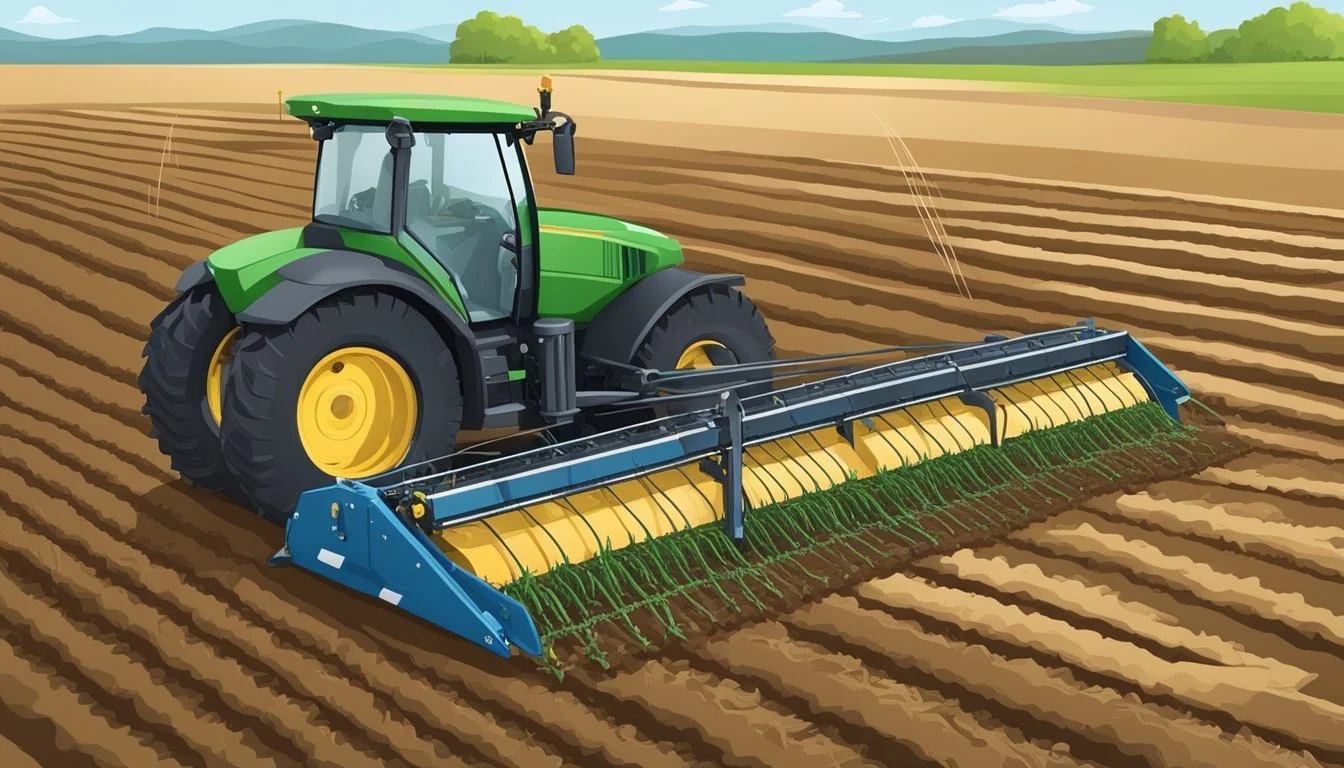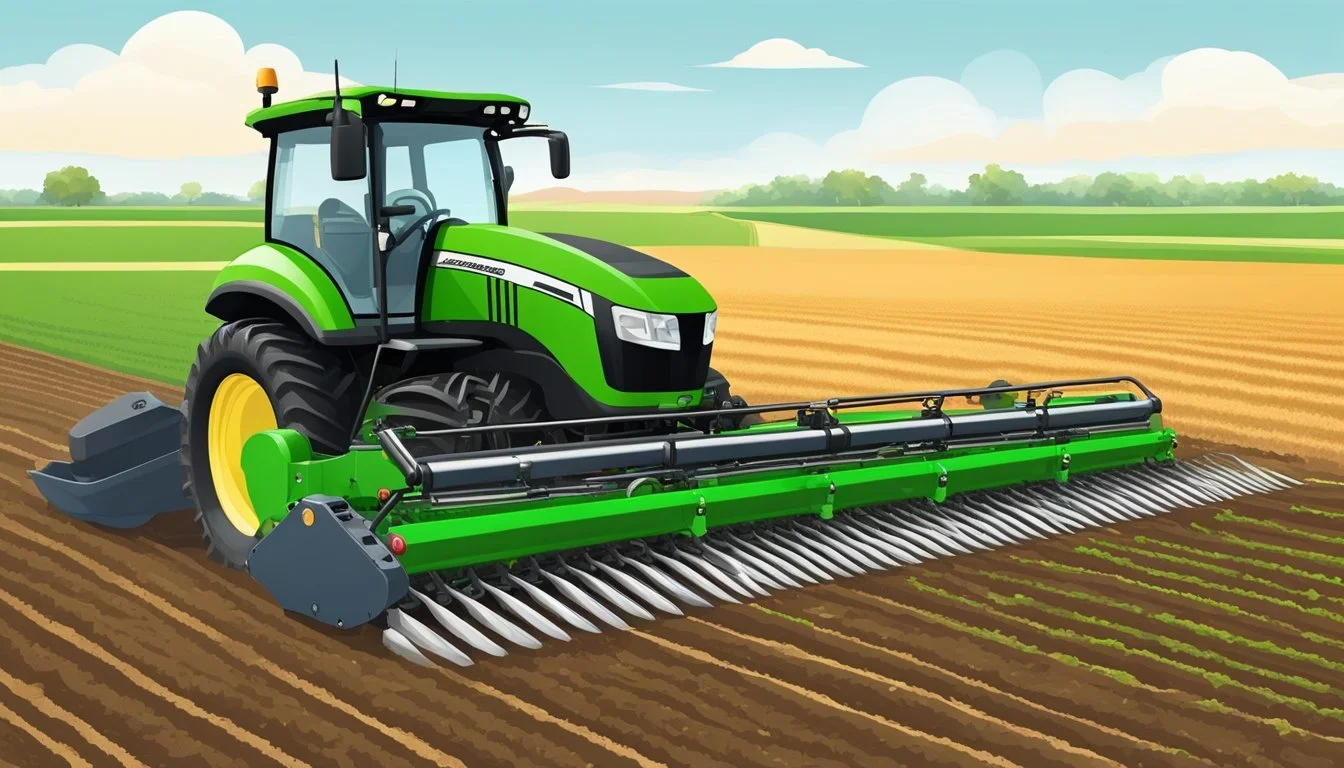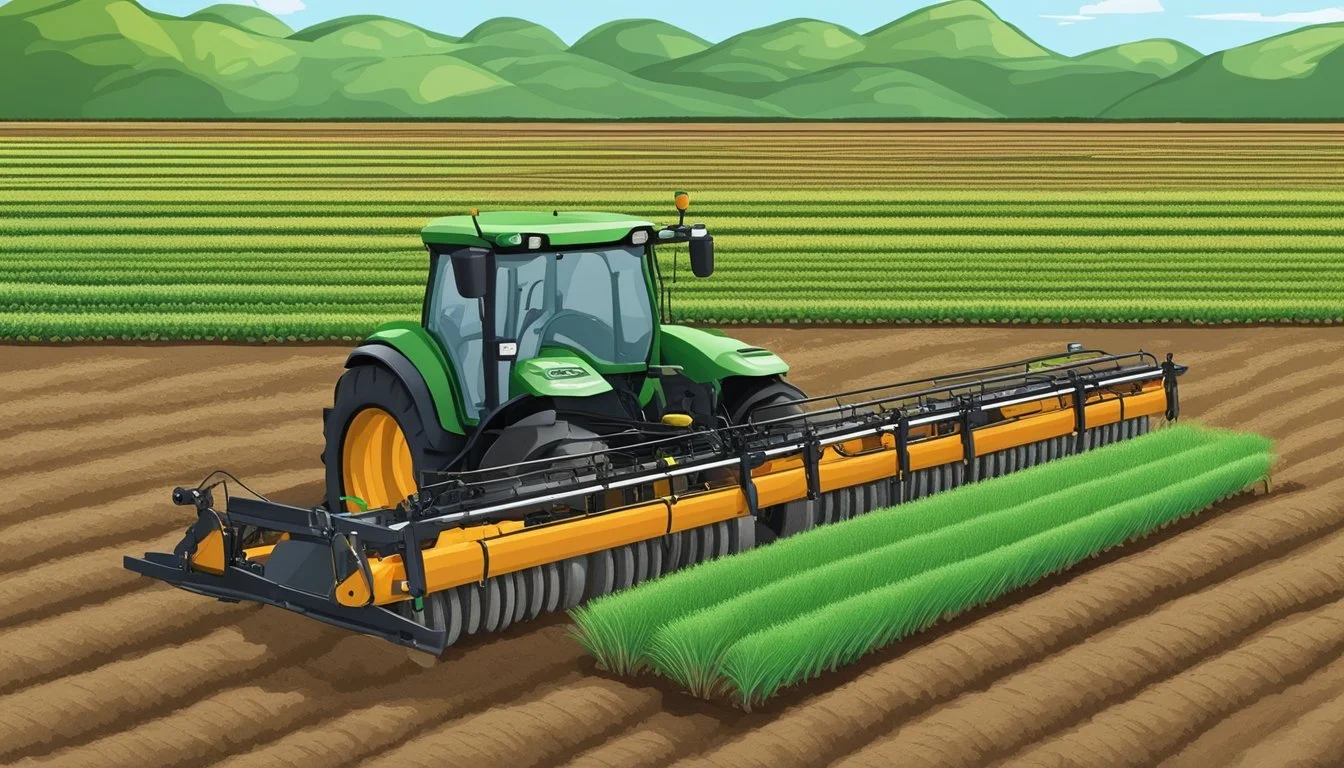Maximize Efficiency and Minimize Waste
The Impact of GPS-Guided Precision Seeders on Homesteading
In the world of homesteading, achieving a high level of efficiency while conserving resources is crucial for long-term sustainability. A GPS-guided precision seeder offers an advanced solution for small-scale farmers and homesteaders looking to cultivate their land more effectively. This technology allows for meticulous sowing of seeds in pre-determined patterns and at precise depths, ensuring optimal plant growth and yield.
Homesteaders can benefit from the incorporation of such precision tools, which assist in reducing seed waste and improving crop density. By confining the seed placement to the ideal locations, a GPS-guided precision seeder minimizes the likelihood of overplanting and helps ensure that each seed's potential is fully realized. This approach not only conserves valuable seeds but also reduces the time and labor associated with thinning and managing excess growth.
Furthermore, the precision seeder's technology is designed to adapt to various soil conditions, enhancing its application across different terrains typically found in homesteading environments. The integration of GPS with the seeding process also paves the way for more detailed record-keeping and analysis, facilitating ongoing improvements to planting strategies and agricultural outcomes on a homestead.
Understanding Precision Agriculture
Precision agriculture has revolutionized how farmers manage land and crops, focusing on efficiency and sustainability. This approach relies heavily on technology and data to make informed decisions in farming practices.
Evolution of Farming Practices
Traditional farming methods followed a one-size-fits-all approach, with uniform application of water, fertilizers, and pesticides across entire fields. As technology advanced, precision agriculture emerged, enabling the optimization of inputs on a per-need basis. This evolution marks a shift from broad-spectrum to targeted farm management, reducing waste and enhancing the sustainability of agricultural operations.
Key Principles of Precision Agriculture
The foundation of precision agriculture rests on two key principles:
Data-Driven Decision Making: By aggregating data from various sources such as soil sensors, weather reports, and crop yields, farmers can analyze and understand their fields with greater accuracy.
Site-Specific Management: This principle involves adjusting farming practices based on varying conditions within a field to apply the right treatment, in the right place, at the right time.
Technology plays a pivotal role in implementing these principles. Equipment with AI capabilities and analytic tools are instrumental for precise measurements, predictions, and operational automation.
Role of GPS in Agriculture
GPS or Global Positioning System is the cornerstone technology in precision agriculture. It allows farmers to conduct accurate field mapping, crucial for:
Determining specific crop needs
Guiding machinery for planting and fertilization
By using GPS-guided equipment such as a precision seeder, agriculturalists can achieve the following:
Minimize Overlap: This leads to reduced waste of seeds, fertilizers, and pesticides.
Maximize Efficiency: Farmers can achieve precise planting, which is fundamental to optimal crop growth and yield.
Through GPS, precision farming becomes not only an innovative concept but a practical solution for sustainable agriculture.
Benefits of GPS-Guided Precision Seeders
GPS-guided precision seeders represent a major technological advancement in agriculture. They are integral to maximizing efficiency and optimizing resource use during planting.
Increased Crop Yield
The deployment of GPS technology in seeding equipment results in a uniform planting pattern. Precise seed placement leads to optimal plant growth conditions and, as a result, maximizes the potential yield per acre. A farmer can expect a more consistent crop because GPS-guided seeders ensure each seed has adequate space to flourish without competition from neighboring plants.
Resource Management and Sustainability
These seeders enable farmers to apply the principle of sustainability in their planting operations. With GPS guidance, seeds are distributed efficiently, which means every seed counts and resource wastage is minimized. This level of resource efficiency contributes to overall farm sustainability by ensuring that inputs like seeds and the labor to plant them are not used more than necessary.
Reducing Environmental Impact
The precision achieved with GPS-guided seeders reduces the likelihood of overlaps and gaps in the planting process, which in turn lessens the need for corrective inputs that can cause environmental impact. By minimizing the use of these inputs, such as additional fertilizer or pesticides to manage uneven growth, these seeders help maintain the balance in local ecosystems and reduce the carbon footprint of farming operations.
Core Components of a Precision Seeder
Precision seeders are revolutionizing homesteading by coupling pinpoint accuracy with advanced technology. These machines ensure the precise placement of seeds while minimizing waste and optimizing resources. The following are the critical technological components that make up a GPS-guided precision seeder.
GPS and Satellite Technologies
GPS and satellite technologies provide the backbone for the functionality of precision seeders. These seeders utilize GPS guidance systems to map out the planting area with remarkable accuracy. Satellite imagery contributes to creating detailed field maps, which sit at the core of strategic seed placement. By leveraging data analytics processed through satellite coordinates, farmers can align their seeding patterns with the exact geospatial data, resulting in uniform crop rows and optimum land use.
Seed Placement Accuracy
The crux of a precision seeder’s success lies in its seed placement accuracy. Systems are designed to ensure that each seed is deposited at a consistent depth and spacing, reducing the chance of overcrowding or resource competition among seedlings. This results in stronger growth patterns and elevated yields. Technologies like Variable Rate Technology (VRT) further optimize seed distribution, particularly in landscapes with diverse soil types or terrain, which directly contributes to enhanced crop performance.
Integration of Onboard Sensors
Precision seeders are equipped with a variety of onboard sensors that play a pivotal role in real-time data collection and decision-making. These sensors detect subtle differences in soil properties, moisture levels, and environmental conditions. The information gathered is then used to adjust seeding rates and depth on the fly, tailoring the planting process to the specific needs of each segment of land. Integrating this sensor data with precision agriculture technologies magnifies efficiency and fortifies the 'smart farming' approach, supporting sustainable agriculture practices.
Implementing Precision Seeders for Homestead Farming
Precision seeders offer small-scale farmers a method to plant seeds more accurately and efficiently. By adopting these tools, homesteaders can achieve cost savings and enhance the efficacy of their precision agriculture practices.
Step-by-Step Implementation Guide
Assessment: Farmers should start by evaluating their land to understand the specific needs and potential benefits of precision seeding technology.
Selection: Choosing a precision seeder model that is compatible with the farm's size and the type of crops grown is essential.
Calibration: The seeder must be calibrated according to soil conditions and the seed type to ensure optimal spacing and depth.
Integration: Implement the seeder into existing farming routines, adapting methods to take full advantage of the technology.
Training: Farmers should allocate time for proper training to operate the seeder efficiently.
Maintenance: Establish a routine for maintaining the equipment to ensure longevity and consistent performance.
Challenges and Solutions in Adoption
Cost Concerns: The initial investment can be offset by the long-term savings in seeds, fuel, and labor.
Learning Curve: Provide or seek training resources to ensure proper use and maintenance of the seeder.
Technology Compatibility: Ensure the precision seeder is compatible with other farm technologies for seamless integration.
Resistance to Change: Demonstrating the seeder's benefits through pilot programs can encourage its adoption.
Cost-Benefit Analysis
Initial Investment: Costs can vary, but investing in a high-quality seeder can lead to significant savings down the line.
Maintenance Expenses: Regular upkeep, while a minor cost, is vital for consistent operation.
Operational Savings: Reduced seed wastage and more efficient land use can result in decreased costs per acre.
Yield Increase: More accurate seeding can lead to improved crop yields and higher revenues.
By considering these detailed aspects, small-scale farmers can implement precision seeders to enhance their homestead farming operations effectively.
Optimizing Usage of Precision Seeders
Precision seeders, equipped with the latest technology, significantly enhance efficiency in planting seeds. They allow for meticulous resource management and ensure that input application is tailored effectively to the unique requirements of the land and crops.
Variable Rate Technology Applications
Variable Rate Technology (VRT) allows for the customized application of seeds based on specific field conditions. This technology employs:
GPS mappings to adjust seed output.
Machine learning algorithms to refine planting patterns over time.
Utilization of data analysis to adapt to soil variability.
Through VRT, farmers can ensure each area of their field receives the optimal seed rate, thus conserving resources and enhancing yields.
Data-Driven Decision Making
The cornerstone of precision seeder optimization is robust data analysis. Decisions are informed by:
Comprehensive soil analysis data that predicts the best seed varieties and quantities.
Real-time data about crop needs guiding immediate adjustments.
Historical data analysis leading to smarter strategies for future planting cycles.
Leveraging this data ensures that every seed counts and growth potential is maximized.
Soil and Crop Analysis
Accurate soil and crop analysis is vital for precision seeder effectiveness. They provide insights on:
Soil fertility levels for informed input application.
Exact crop needs, allowing for precise adjustments in seed distribution.
Detection of micro-environmental variations within fields.
Farmers can tailor their seeding approach to match these conditions, ensuring efficient use of resources and reduced waste.
Future Trends in Precision Seeding Technology
Precision seeding technology is on the cusp of transformation, with emerging trends poised to redefine efficiency and sustainability in homesteading.
Advancements in AI and Robotics
The intersection of AI (Artificial Intelligence) and robotics in precision seeders is driving a new era of automated farming. AI algorithms are becoming increasingly adept at decision-making, leveraging large datasets to predict the optimal planting patterns and schedules. This intelligence allows for real-time adjustments while seeding. Robotic arms equipped with sensors will enable precision seeders to plant seeds at the ideal depth and spacing, reducing seed waste and enhancing crop yields.
Influence of Climate Change on Seeding
Climate change is a pressing factor steering advancements in precision seeding technologies. Seeders will increasingly rely on data regarding soil moisture levels and weather patterns to adapt sowing strategies. This adaptability helps ensure that crops are sowed during the optimal window for germination and growth, which is crucial as weather patterns become more unpredictable due to climate change.
Integration with Smart Farming Systems
Precision seeders will become a component of Smart Farming Systems, utilizing the Internet of Things (IoT) to synchronize with other farm tools and management systems. The IoT enables seamless data exchange between devices, allowing farmers to monitor and control the entire seeding process through a centralized platform. Advanced technologies such as machine learning analyze the data to recommend improvements, resulting in a highly efficient, interconnected homesteading environment.
Support and Resources for Farmers
Farmers looking to invest in a GPS-guided precision seeder can access a variety of resources and support mechanisms. These are designed to enhance farm profitability through precision farming, while also considering financial assistance, training opportunities, and the backing of research and community involvement.
Financial Assistance and Subsidies
Farmers often can seek financial assistance and subsidies to offset the initial cost of precision farming equipment. Funding can come from various sources including:
Government Grants: Programs are available at both federal and state levels that provide capital to support the adoption of advanced agricultural technologies.
Subsidy Schemes: Specific schemes may target small-scale farmers or sustainable farming practices, offering discounts or rebates on equipment such as precision seeders.
Eligibility Criteria:
Ownership of agricultural land
Adherence to sustainable farming practices
Implementation of precision agriculture technology
Training and Education Programs
The incorporation of precision farming technologies is reinforced by training and education programs. These resources are vital for farmers to effectively deploy and utilize new equipment. Training resources may include:
Online Courses and Webinars: Covering the basics of precision agriculture and specific operational techniques for GPS-guided equipment.
Workshops: Conducted by agricultural extension services or equipment manufacturers, providing hands-on experience.
Program Outcomes:
Improved understanding of precision seeding technology
Enhanced ability to integrate new systems with existing agricultural practices
Research and Community Support
Ongoing research and development are crucial for advancing precision agriculture. Farmers can engage with these resources through:
University Research Projects: Collaboration with academic institutions can lead to participation in studies and trials that further the knowledge and effectiveness of precision equipment.
Farmer Cooperatives: Participating in or forming co-ops where members can share knowledge, resources, and experiences with precision seeding and other innovations.
Community Benefits:
Shared wisdom on best practices and pitfalls
Joint investments in shared technology or services
Case Studies: Success Stories of Precision Seeding
Precision seeding technology, particularly GPS-guided systems, has revolutionized both small-scale homesteads and large-scale agricultural operations. Highlighting its impact, documented case studies underscore improvements in productivity and profitability due to optimal seed placement and reduced waste.
Impact on Small-Scale Homesteads
On small homesteads, precision seeders have made it possible for farmers to operate more efficiently. For example, a Vermont-based homestead reported a 30% increase in crop yields due to more accurate seed spacing, which improved germination rates and plant health. By minimizing seed overlap and gaps, these homesteaders also saw a significant reduction in seed waste, contributing to cost savings and higher profit margins.
Increased Yield: Thanks to precision seeders, small-scale farms often achieve higher productivity per acre.
Reduced Waste: Exact seed placement translates into less waste, saving money typically expended on excess seeds.
Data from another case study focusing on a homestead in Colorado highlighted that the adoption of a GPS-guided precision seeder led to a noticeable decrease in labor hours, as the seeder required fewer passes over the field, thus saving time and fuel.
Large Scale Farming Transformations
In the context of large-scale agriculture, precision seeding has catalyzed a farming transformation. An expansive grain farm in Kansas documented that after switching to GPS-guided seeding, the precision technology not only improved seed placement but also enhanced the application of fertilizers, reducing overlap to just 2% from a previous 10%. This strategic investment increased their ROI significantly, with some reports indicating a profitability surge by 20% annually, thanks to optimal resource use and lowered input costs.
Enhanced Fertilizer Application: Precision reduces overlaps, which is particularly beneficial for large fields where errors are amplified.
Profitability Surge: Improved efficiency and reduced input costs directly bolster the bottom line for large farms.
Developments in precision agriculture technologies continue to drive advancements in the sector, with robust evidence to support their effective application across different scales of farming. These case studies are a testament to the substantial benefits of adopting precise farming methods, such as GPS-guided seeders, in both increasing efficiency and minimizing waste.
Ethical Considerations and Regulatory Compliance
Precision seeders equipped with GPS technology represent a significant advancement in agricultural efficiency, but they also present unique challenges in terms of data privacy and adherence to legal standards.
Ensuring Data Privacy and Security
The integration of GPS technology in precision seeders involves the collection and use of detailed geospatial data. Farmers must ensure that this information is:
Protected: Implement robust security measures to safeguard data from unauthorized access.
Compliant: Adhere to privacy laws such as the General Data Protection Regulation (GDPR) for individuals within the European Union.
Farmers should stay informed about the latest privacy standards and invest in technologies that prioritize the security of their data.
Navigating Legal Standards
Farmers using GPS-guided precision seeders must navigate a complex landscape of agricultural regulations. They should ensure their operations comply with:
Safety Regulations: Use equipment that meets safety standards to prevent accidents and ensure the well-being of operators.
Operational Standards: Follow best practices in equipment use, which might be established by agricultural agencies or industry groups.
Adhering to these regulations not only promotes lawful farming practices but also instills confidence in the product's quality and the farm's operational integrity.







